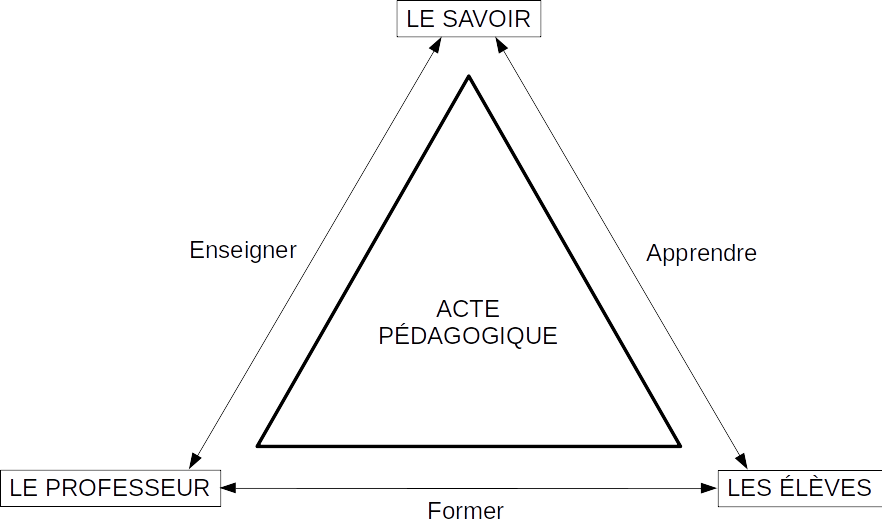
Boris Chevrot. From social isolation to sociable territories. Thesis in sociology
It's a thesis that points to the resilience and power of territories and their ability to exist.
Publish at January 05 2021 Updated January 06 2022

What is teaching? The answer to this question is broad. Everyone will be able to have their own vision of teaching. Moreover, various experts in didactics have theorized on the subject. Among the best known is Jean Houssaye who in 1988 had, among other things, written about the triangle of pedagogy. The teacher, the knowledge and the student form the three vertices of the figure.

For a brief reminder, the didactic relationship is the relationship maintained between
This triangle would therefore be representative of all the possible postures in teaching knowledge. However, this can take place in different ways. The best known is that of instruction in which the teacher uses lectures to share the concepts with the learning group. However, since then, other more active approaches have emerged. These are instead challenging the role of teachers.
In fact, the issue of more active training is growing as technologies advance. For example, the flipped classroom is already an early model of this type of pedagogy where the instructive part is done before the face-to-face arrival. The teacher becomes more of a facilitator who organizes activities that will allow the acquired knowledge to be put into practice more concretely. He also finds himself as an advisor who can answer questions from students who have not understood everything.
Project pedagogy also profoundly modifies the role of the teacher since in it, it is the students who are responsible for learning. Since the quest for knowledge is controlled by the class, he must be a guide who will frame the choices and propose situations of exploration. The teacher will also be the motivator who pushes the learners to solve a problem or to accomplish a challenge. Finally, he will have a place as a mediator who will support his class and organize activities to reach the goal set by the group.
Of course, this major change in the role of the teacher can discourage many. Besides, active pedagogy is still marginal because it requires a profound transformation in course design. Many are discouraged by the time-consuming aspect of having to redesign activities around a facilitator/guide/mediator role rather than just an instructor. Fortunately, there are a growing number of online resources, such as these "Active Pedagogy Vignettes" from Polytechnique Montreal, which offers a hundred cards to put learners into action.
For that matter, many received ideas circulate about active pedagogy. How will students do without a model to emulate? Yet trial and error is a fundamental aspect of learning. In cooking, for example, we can follow a recipe word for word on the Internet. However, it will not necessarily correspond to our tastes. A cook in training will then experiment, modify ingredients and develop personal techniques to arrive at a result that satisfies him. Furthermore, we must refute the idea that the teacher no longer transmits knowledge with these approaches. This is not true, he continues to do so. However, rather than imposing his plan, he exposes knowledge based on the questions of his class.
The transition from passive to active pedagogy is not that complex, but it seems all the more so because teacher training does not yet really prepare future teachers for these different approaches and roles. It is, however, possible for those who would like to transform their pedagogical approach.
Illustration : Stefan Meller by Pixabay
References :
Ben Salah, Besma. "De La Pédagogie Active Pour De L'apprentissage Actif." GoMyTech. Last updated : 29 October 2020.
https://gomytech.co/de-la-pedagogie-active-pour-de-lapprentissage-actif/
"The Roles Of The Teacher And The Student In Project-Based Pedagogy." Teaching Well. Last updated : 25 May 2020.
https://www.bienenseigner.com/les-roles-de-lenseignant-et-leleve-en-pedagogie-de-projet/
"Should We Give Up Active Pedagogy? - Inductive VS Explicit Method." M. Belleville-Douelle. Last updated : 30 March 2020.
https://mbellevilledouelle.fr/pedagogie-active-explicite/
Lacasse, Michel. "La Formation Inversée : Une Stratégie De Conseillance Pédagogæe Pour Passer De La Formation à L'accompagnement." FGA RECIT. Last updated : 11 May 2020.
https://www.ticfga11.ca/formation-inversee-conseillance-accompagnement/
"Le Triangle Pédagogique De Jean Houssaye." Gallika.net. Last updated March 2009.
https://gallika.net/?Le-triangle-pedagogique-de-Jean
"Les Grandes Méthodes Pédagogiques Qui Existent." Onisep Reso. Last updated : 23 January 2020.
https://www.onisep-reso.fr/quelles-sont-les-differentes-methodes-pedagogiques/
Rheaume, Catherine. "Le Site Vignettes De Pédagogie Active : Une Incroyable Source D'inspiration." Profweb. Last updated : 13 October 2020.
https://www.profweb.ca/publications/articles/le-site-vignettes-de-pedagogie-active-une-incroyable-source-d-inspiration-2
100 Generic Active Pedagogy Activities - Complete Sheets - Free
https://fr.cursus.edu/22407/100-activites-generiques-de-pedagogie-active-fiches-completes-gratuit
Access exclusive services for free
Subscribe to our newsletter on pedagogy and educational technologies
You can also index your favorite resources and retrieve your viewing history.
Subscribe to the newsletter